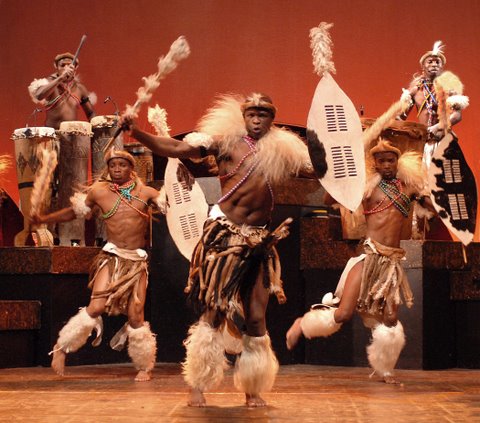Vogue Theatre
Umoja: The Spirit of Togetherness
Dates 1 - 18 December 2005 at 20.00 Venue Vogue Theatre Reviewer June Heywood
 |
Go hear, see, feel this show. Experience every emotion through the story of South African music.
Co-created by childhood friends who grew up in Soweto, Todd Twyla (Choreographer) and Thembi Nyandeni (Production and Costume Designer) used their fame as performers to inspire and train enough disadvantaged boys and girls from the Johannesburg township to mount the worldwide hit show Umoja (Swahili for the spirit of togetherness).
As told by the Narrator, Penuel Bhekisitha Ndaba (Hope), the audience learns through tribal music and dance of a man's life journey from a South African village to a city where he experienced years of apartheid to emerge in the freedom of the present day.
Throughout the two and a half-hour show the forty singers, dancers, drummers, and marimba players perform leaps, high kicks, acrobatics, and top speed drumming with ceaseless energy.
The women's Venda Snake Dance was amazing. To the mesmerizing beat of the bomba drum, with their upper bodies lying on the person's back in front, the unit undulated in a song of praise to the old storyteller "who relates the traditions of the past to the children of today."
At times, the narrative was humerous as when the beer pot was passed round and the men got frisky, staggered and stomped to a drumming dance. Also funny were the early '50s Talent Competition at the YMCA, Durban and the Back of the Moon Shebeen scenes. "The Tula Baba" was a sad lullaby sung in a capella harmony by mothers to the children of fathers who left the villages for work. Sometimes the fathers would return many months later, often not at all.
Act Two began with the drummers running down both aisles wearing yellow overalls, red headbands, and black gumboots. As they were forbidden to speak when working, South African Black gold miners communicated by tapping on their boots. "Our music helped keep us human," said the Narrator.
Dressed as cheerleaders
and using empty pop cans as clacking instruments, the Tin Can Girls sang
a lively song about HIV awareness.
Early in the 70s, the Narrator explained, "There was a Gospel explosion
from across the seas." He asked the audience to shout "Allelulia"
once then again.
The performers entered dressed as members of a choir in white albs. They sang six numbers from both outside aisles and on the stage. The intricate dance patterns were seamlessly executed as the singers swayed in the background to the five solos or wove between each other.
Dressed in the costumes of their major parts, the dancers returned to the stage for the "Club Scene - The Current Kwaito Dance Craze in South Africa." The liner notes to the program say, "Take bold funky lyrics, a mixture of local languages and street slang, a unique form of music, dress, and dance, and you have Kwaito - the symbol for (today's) South African youth."
The musical journey having come full circle, members of the audience were sated with the sights of the costumes and dances, hearing the songs and history of South African, and still feeling the heartbeat of the drums in their souls.
© 2005 June Heywood